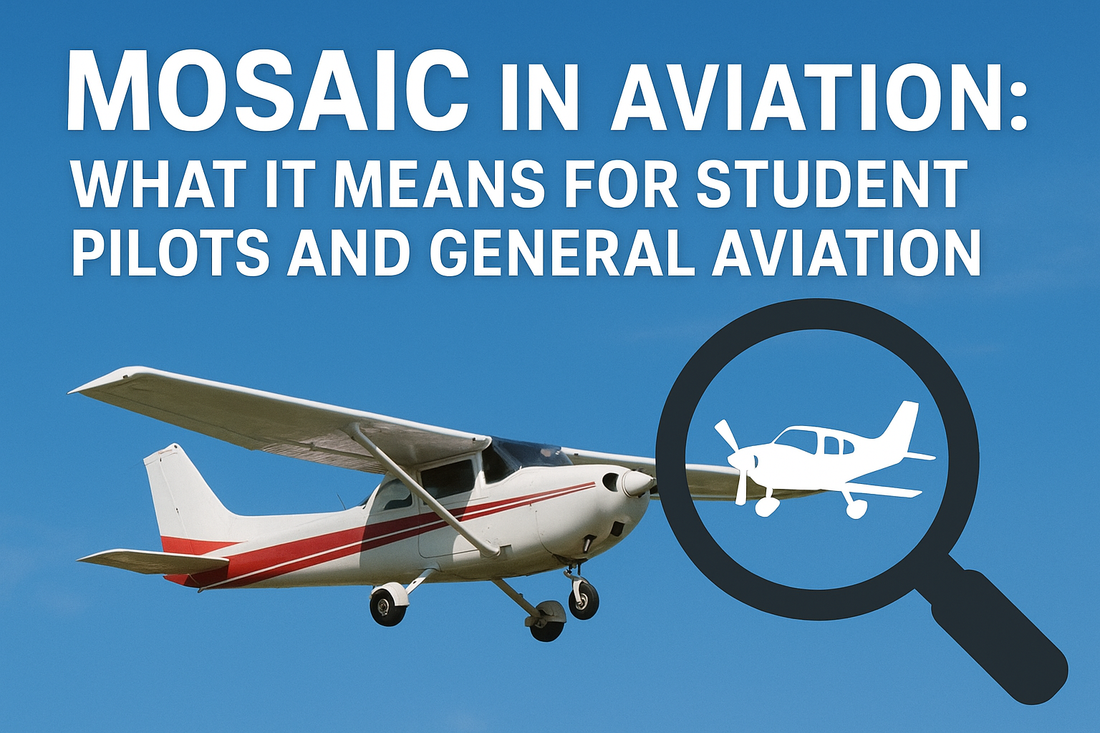
MOSAIC in Aviation: What It Means for Student Pilots and General Aviation
By CFI Brent Taylor
As your CFI, one of my jobs is to keep you up to date on the latest changes in aviation. Every few years, the FAA makes a rule change that really impacts how we fly, what we can train in, and even which certificates are most useful. The newest and biggest update in decades is called MOSAIC.
If you’ve heard the term thrown around the hangar or seen it online, let’s break it down together. What is MOSAIC? Why does it matter for general aviation? And most importantly—what does it mean for you as a student pilot?
What Is MOSAIC in Aviation?
MOSAIC stands for Modernization of Special Airworthiness Certification. It’s the FAA’s major overhaul of the rules governing Light Sport Aircraft (LSA) and the Sport Pilot certificate.
Before MOSAIC, Light Sport Aircraft were limited by strict rules:
-
Max weight of 1,320 pounds (1,430 for seaplanes).
-
Two seats only.
-
Fixed-pitch propellers.
-
No retractable gear (except amphibious planes).
-
Limited performance and avionics.
This meant only a very small set of airplanes qualified—mainly small two-seaters like the Flight Design CT, Remos, or newer LSAs from Europe. It left out popular legacy trainers like the Cessna 150/152 or Piper Cherokee.
MOSAIC changes all of that. It modernizes the definition of LSAs, expands the privileges of Sport Pilots, and opens up much more of the general aviation fleet.
Key MOSAIC Rule Changes
Here’s what makes MOSAIC such a big deal for pilots and flight schools:
1. Higher Weight Limit
LSAs can now weigh up to 3,000 pounds in some cases. This includes classic four-seat aircraft like the Cessna 172, Piper Cherokee, and similar airplanes.
2. More Aircraft Features Allowed
Under MOSAIC, LSAs can now have:
-
Constant-speed (adjustable) propellers.
-
Retractable landing gear where appropriate.
-
More advanced avionics (including glass panels).
This means Sport Pilots can fly more capable and better-equipped airplanes.
3. Expanded Sport Pilot Privileges
Previously, Sport Pilots were limited to small two-seat LSAs. With MOSAIC, they now have access to many more aircraft types, including legacy four-seaters. This dramatically increases the usefulness of the Sport Pilot certificate.
Why Did the FAA Approve MOSAIC Now?
The Sport Pilot and Light Sport Aircraft rules came out in 2004. So why did it take until 2024 for MOSAIC to be approved?
A few reasons:
-
Safety data. The FAA wanted 20 years of accident data to make sure the Sport Pilot system was safe before expanding it.
-
Industry readiness. The LSA market has matured, with better designs, more manufacturers, and modern avionics.
-
Pilot demand. Organizations like AOPA and EAA have pushed for years to expand the rules to include more practical airplanes.
-
GA health. General aviation has faced rising costs and declining numbers. The FAA sees MOSAIC as a way to keep flying more accessible.
After years of proposals and public comment, the final MOSAIC rule was adopted in 2024 and officially takes effect in 2025.
Who Benefits From MOSAIC?
MOSAIC is designed to strengthen all of general aviation. Here’s how it affects different groups:
Student Pilots
-
More training options: You may be able to learn in classic Cessna 172s or Cherokees under Sport Pilot rules.
-
Lower costs: More airplanes available means potential savings on rentals and training.
Sport Pilots
-
Biggest winners under MOSAIC. You’re no longer limited to small two-seaters—many four-seat GA aircraft are now in reach.
-
Greater utility: Sport Pilot is now a much more attractive entry point for new aviators.
Flight Schools
-
Can expand their fleets with legacy trainers.
-
Can attract more students who see Sport Pilot as a practical, affordable way into aviation.
Aircraft Owners
-
Aircraft like Cessna 150s and Cherokees gain new value because they now qualify under Sport Pilot privileges.
General Aviation as a Whole
-
More pilots = stronger airports, FBOs, and communities.
-
Lower barriers to entry = a healthier future for GA.
MOSAIC vs Old LSA Rules
Let’s do a quick side-by-side comparison:
| Feature | Pre-MOSAIC LSA | MOSAIC LSA |
|---|---|---|
| Max weight | 1,320 lbs | ~3,000 lbs |
| Seats | 2 | Up to 4 |
| Propeller | Fixed-pitch only | Constant-speed allowed |
| Landing gear | Fixed only (except amphib) | Retractable allowed |
| Avionics | Simple/basic | Advanced glass panels OK |
| Eligible aircraft | Small LSAs only | Includes many legacy GA trainers |
What MOSAIC Means for You as a Student Pilot
If you’re working on your Private Pilot license right now, here’s how MOSAIC affects you:
-
More choices for training aircraft. Your school may be able to add affordable legacy planes to the fleet.
-
Flexibility for the future. If you want to stop at Sport Pilot, you’ll still have access to a useful range of airplanes.
-
More affordable ownership. When you’re ready to buy, there will be more options that fit under Sport Pilot/LSA rules.
And if you plan to go beyond Private—Instrument, Commercial, CFI—MOSAIC strengthens the training pipeline by attracting more students into aviation in the first place.
Why MOSAIC Matters for General Aviation
As a CFI, I’ve seen first-hand how much the rising cost of flying discourages new pilots. MOSAIC is designed to fix that by:
-
Making flying more affordable.
-
Bringing more airplanes back into use.
-
Giving pilots more flexibility in how they enter aviation.
-
Revitalizing the used aircraft market.
It’s not just about Sport Pilots. It’s about strengthening the entire aviation community.
Looking Ahead: The Future Under MOSAIC
Like any major FAA rule change, it will take time for everyone to adjust. Flight schools will adapt their fleets, examiners will learn the new standards, and pilots will explore new privileges.
But long term, MOSAIC represents a turning point. It shows the FAA is willing to make aviation more accessible, not less. That’s a win for every pilot—from student to airline captain.
Final Thoughts
Flying has always been about freedom. For too long, the Light Sport rules were too restrictive to truly open aviation to everyone.
With MOSAIC, the FAA has finally modernized the system. More airplanes, more options, more pilots—that’s the recipe for a healthy future in general aviation.
So as you continue your training, remember: MOSAIC isn’t just a policy change. It’s a new opportunity. The airplanes tied down on the ramp, the ones that used to be “off-limits” to Sport Pilots? Many of those are about to become fair game.
That’s exciting—for you, for me, and for the future of flying.
By CFI Brent Taylor
If you’re a student pilot looking for helpful study tools and flight gear, NorthstarVFR.com is a trusted resource designed with your training in mind. We offer carefully curated pilot supplies and study materials, including our popular Pre-Tabbed FAR/AIM, Oral Exam Guides, kneeboards, logbooks, and more. Everything is selected to help you stay organized, pass your checkrides, and fly with confidence. Check it out and set yourself up for success in the cockpit.
